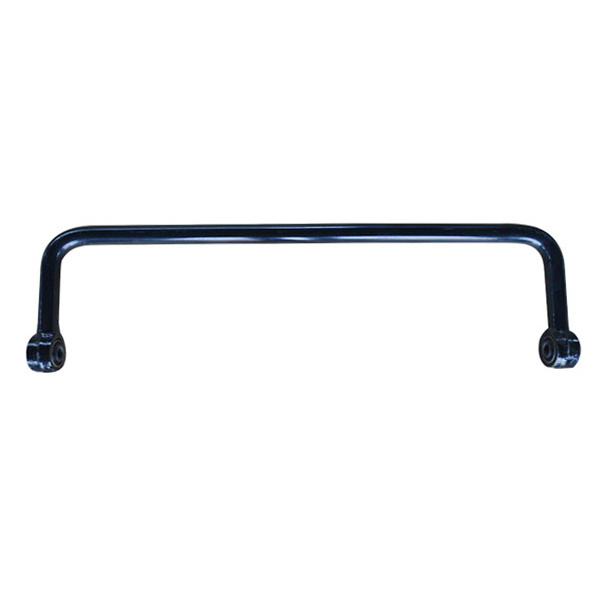Hot Products
Solid stabilizer bar, round steel 50, tapered hole
Sway bar (sway bar, anti-roll bar, stabilizer bar), also known as anti-roll bar, balance bar, is an auxiliary elastic component in automobile suspension.
hiddenValue
- Description
-
Sway bar (sway bar, anti-roll bar, stabilizer bar), also known as anti-roll bar, balance bar, is an auxiliary elastic component in automobile suspension.In order to improve the driving comfort of the car, the suspension stiffness is usually designed to be relatively low, and the result is that the driving stability of the car is affected. For this reason, a horizontal stabilizer bar structure is used in the suspension system to increase the stiffness of the suspension roll angle and reduce the vehicle body inclination angle.The function of the stabilizer bar is to prevent excessive lateral roll of the body when turning, and try to keep the body balanced. The purpose is to reduce the degree of lateral roll of the car and improve ride comfort. The stabilizer bar is actually a horizontal torsion bar spring, which can be regarded as a special elastic element in function. When the body only moves vertically, the suspensions on both sides have the same deformation, and the stabilizer bar does not work. When the car turns, the body rolls, and the suspension on both sides of the car is inconsistent. The outer suspension will press against the stabilizer bar, and the stabilizer bar will be twisted. To the role of lateral stability.StructureThe stabilizer bar is a torsion bar spring made of spring steel with a "U" shape and is placed horizontally at the front and rear of the car. The middle part of the shaft is hingedly connected to the body or frame with a rubber bushing, and both ends are connected to the suspension guide arm through rubber pads or ball pins at the end of the side wall.Working PrincipleIf the left and right wheels bounce up and down at the same time, that is, when the body only moves vertically and the deformation of the suspensions on both sides is equal, the stabilizer bar rotates freely in the bushing, and the stabilizer bar does not work.When the suspension on both sides deforms unequal and the body tilts laterally to the road, one side of the frame moves closer to the spring support, the end of the stabilizer bar moves upward relative to the frame, and the other side of the frame is away from the spring For the support, the end of the corresponding stabilizer bar moves down relative to the frame. However, when the body and the frame are tilted, the middle of the stabilizer bar does not move relative to the frame. In this way, when the vehicle body is tilted, the longitudinal parts on both sides of the stabilizer bar deflect in different directions, so the stabilizer bar is twisted and the side arms are bent, which plays a role in increasing the angular rigidity of the suspension.The torsional internal moment generated by the elastic stabilizer bar hinders the deformation of the suspension spring, thereby reducing the lateral tilt and lateral angular vibration of the vehicle body. When the torsion bar arms at both ends bounce in the same direction, the stabilizer bar does not work. When the left and right wheels bounce in the opposite direction, the middle part of the stabilizer bar is twisted.ApplicationIf the vehicle roll angle stiffness is low and the vehicle body roll angle is too large, a stabilizer bar should be used to increase the vehicle roll angle stiffness. The stabilizer bars can be installed on the front and rear suspension separately or at the same time as required. When designing the stabilizer bar, in addition to the total roll angle stiffness of the vehicle, the ratio of the roll angle stiffness of the front and rear suspension should also be considered. In order to make the car have understeer characteristics, the roll angle stiffness of the front suspension should be slightly greater than that of the rear suspension. Therefore, most models are equipped with stabilizer bars on the front suspension.Generally, the material is selected according to the design stress of the transverse stabilizer bar. At present, the 60Si2MnA material is more widely used in China. 50CrVA material. 42CrMo material, 35CrMo material. In order to increase the service life of the stabilizer bar, shot blasting should be carried out.Among them, it is divided into solid round steel (60Si2MnA material, 50CrVA material) stabilizer bar, specification: φ28-φ70; hollow round tube (42CrMo material, 35CrMo material) stabilizer bar, specification: φ36×6-φ65×14.Keywords:
- bar
- stabilizer
- suspension
Send Inquiry
NOTE: Please leave your email, our professional person will contact you asap!
Related products
Contact Us
language
English
العربية
বাংলাদেশ
Български
Hrvatski
Česky
Dansk
Nederland
 Esperanto
Esperanto
Slovenski
Filipino
Suomi
Français
Maori
 Shqiptare
Shqiptare
Georgian
 Euskara
Euskara
Deutsch
Ελλάδα
ישראל
इंडिया
Magyarország
Ísland
Indonesia
Irlanda
Italia
日本語
Sovensko
Հայաստան
한국
Kyrgyz
ປະເທດລາວ
 Zulu
Zulu
Latvian
Lithuanian
Luxembourgish
 Latinus
Latinus
Macedonian
Малайская
Maltese
Монгол улс
 Cymraeg
Cymraeg
ဗမာ
 தமிழ்
தமிழ்
नेपाल
Norge
ایران
Polska
Portugal
România
Российская
Србија
 Slovak
Slovak
Србија
 Slovak
Slovak
Bosanski
Slovenian
Беларус
España
Sverige
Точик
ประเทศไทย
Türk
Azərbaycan
Uzbek
 Afrikaans
Afrikaans
Việt Nam
Qingzhou City, Shandong Province
Our Products
Mobile Site

Licence





